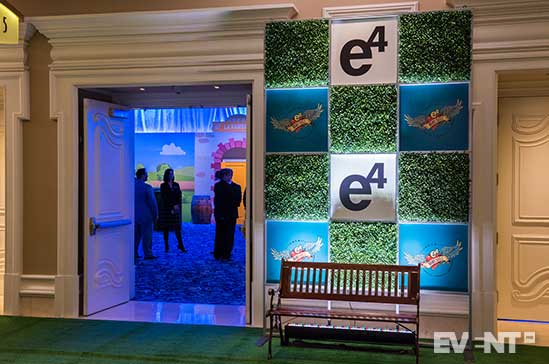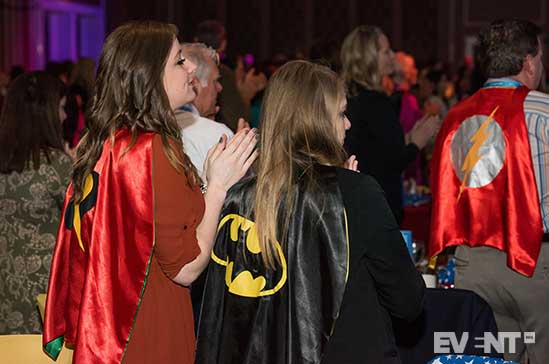This is a sponsored post by Maritz Global Events. More information about Event Manager Blog’s sponsored posts.
Years ago, event branding generally mirrored that of the hosting organization. Event ‘branding’ was reduced to easily recognizable stylistic elements – fonts and colors, a logo. Now, event branding has evolved past that and is more about messaging, sentiment, and a carefully crafted persona that is a key component of the event experience.
Your event branding is a promise to the audience that speaks to the objective of your event, what it means to be someone who attends it, and what attendees can expect when they get there. And, as with any aspect of your event, it must be refreshed and evolve periodically to fully serve your organization and audience.
In this article, we’re going to look at:
1. Event branding dynamics: what’s changed and why it matters
2. Common marketing challenges and signs your event brand needs a refresh
3. Tips for refreshing your brand
If you thought you knew everything about event branding, it is time to take a second look.
Event Branding Dynamics Are Changing
Successful events share a purpose and set values with their audience. One of the most effective ways to communicate that alignment is through branding.
In the past, events looked to their parent entity or stakeholders to define the brand. Basic aesthetic style guidelines were followed, and naming conventions were simple, straightforward indications of who put the event on, where it was located, and maybe the year: something like ‘The Plumbing Association of Northwest Utah Annual Meeting 2004.’
While there is a practicality there, events with their own brand identity are gaining momentum. To be ‘on brand’ now is less about wearing matching colors and having your parent organization’s name on every coaster.


Today, it is more about embodying the persona of the brand in everything you say and the values you communicate. As a result, it has become a much more powerful force in targeting, resonating with, and ultimately attracting an audience. Value-based decision making allows attendees to feel good about coming to your event and supporting your brand.
This coherent, branded message carried throughout the attendee journey has become an essential part of the event experience. In fact, failing to refresh your brand and ensure its alignment with your values and those of your target audience can have stagnating effects on your attendance.
Common Marketing Challenges and Signs Your Event Brand Needs a Refresh
Mere fonts and logos aren’t enough to produce and sustain the tight relationship desired by today’s event audiences. As it does for most of us, participating in something that has value is becoming a factor in their ROI considerations.
Communicating that value well is going to require more than fonts and logos. Here are some signs and symptoms that you might need to refresh your brand:
-
Stagnation Beyond Marketing Influence
Stagnating registration/attendance despite investment in traditionally high-performing marketing practices (content marketing, lead nurturing, email lists, etc.) may indicate a disconnect or failure in value communication.
If the use of these best marketing practices are not affecting attendee numbers or registration, there is likely a disconnect with your brand and value proposition.
-
A Lack of Value-Based Positioning
If similar events with more value-based positioning and event-specific branding are seeing increases in sales or sellouts and you are not, you should take a page from their book. Analyze other events in the same industry, of the same size, or appealing to the same audience.
How are they communicating their values? What personality can you ascribe to their events, and how does that affect the audience they attract?
-
A Divergent Mission from the Parent Organization
If your event is a product announcement or employee meeting, it makes sense to keep the branding tightly aligned with your company marketing. You want it to be recognizable and attributable to the larger entity, as these events are merely extensions or components of the company mission.
However, in the case of corporate social responsibility events and others where the mission is relatively independent from that of the parent company, the event branding should reflect that.
There are also times when an event that’s tightly aligned with the hosting organization — a user’s conference, for example — can still benefit from independent branding. If the goal behind the user’s conference is to showcase the foremost authorities for an industry or type of software, an education-focussed brand for the event will help to add credibility, while a too company-centric brand for the event runs the risk of seeming too salesy or self-promotional.
-
No Unique Value Proposition
If the difference between your event and events in the same industry/vertical isn’t clear, focus on differentiating it through a value-based event brand. If you don’t, it can be difficult for potential attendees to do so on their own. You need branding and a strong marketing message to make it clear what you offer differently and why someone needs to go to your event as opposed to waiting for the next one like it.
Music festivals are a great example of this. They often run in a series with different locations, and the line-up appears at each one. If you’re running one leg of the series, you need to be able to communicate to the audience that your event is different and has a unique value, or you might be passing attendance to the next stop.
-
Branding with an Ineffective Focus
If your brand and messaging emphasize the company affiliation and not the attendee experience, there is a disconnect and an inefficiency that is costing you guests. While attendees may appreciate your company brand, an event requires a much more human side to trip guests’ attention. Even in situations where attendees make decisions based on the brand (an Apple event, for example), that loyalty springs from personified values they associate with the brand. It is the culture they love and respond to.
Undergoing a brand refresh requires deliberation and thought about the attendee experience, and undergoing some value-based decision making, which we will cover in the next section.


How to Keep Your Event Branding Fresh
If you think your event branding might have become a bit stale, the following ideas will help you realign it and solve some of the major event challenges mentioned above.
Think About Giving Your Event its Own Brand
Allow the event its own independent brand identity to increase the audience engagement. Many events are transcending their organizer’s group to achieve a more holistic and inclusive feel.
INBOUND by HubSpot and SalesForce’s DreamForce are some examples. These events started as user conferences and have evolved into preeminent marketing and sales conferences that attract attendees who don’t all necessarily even use the software. The learning and networking have outpaced the parent brand and given these events their own stellar reputations.
IT ALL STARTS WITH UNDERSTANDING AND KNOWING YOUR AUDIENCE.
As Maritz Global Events explained in a recent webinar, taking an empathetic perspective is the place to start with designing an event brand for the people – not just the organization.
Analyze past behavioral data. Research your demographic. Watch the body language of guests. Understand what attracts them to your event and what you could do more of to get them to take notice. This all feeds into the brand promise.
Make Sure You Nail the Basics
The core tenet of any brand should be consistent quality. Look at ways to smooth out processes and reduce wait times. Where is there room for improvement? Do attendees congregate in a small space, and can you usher them into somewhere more comfortable?
The attendee experience is the most fundamental thing to look after when maintaining a good brand, and a poor experience will negatively impact it.
Only once you’ve attended to the basics can you start focusing on creating a shared culture. Think about the commonalities of your organization and what is important to your audience. How can you align your brand to become the answer to what they’re seeking?
Your event brand is expected to define and distinguish your event. It speaks to who you are as an event-goer, your interests, and what values you espouse.
Value-Orient Your Brand Identity
Align your brand with the aspects, causes, and preferences that are important to your attendees. Get behind an organizing principle and flesh out a framework that goes beyond slogans. Provide a place where attendees feel among a group that shares their values. Through shared values, your event becomes something they must attend.
MAKE SURE ALL YOUR MESSAGING IS ALIGNED.
Event branding should be consistent across all your communications. Nothing undermines a value-based position quite like inconsistency.
Previous marketers would meticulously check that all the branding guidelines were met. Now that your brand is more a persona than a set of defined styles, your event identity should be echoed in every piece of the event, including sessions, venues, websites, content, and all communications.
Branding encompasses a much larger scale than it used to so let’s focus on an event example.
Examples of Branding Across Event Components
If your event branding and the event itself embraces diversity, the following areas should also mirror the message including:
- Session leaders from diverse backgrounds
- The opportunity for all voices to be heard during sessions
- Images reflecting a diverse audience used in marketing collateral
- Content that reflects multiple opinions
- Testimonials from past attendees from diverse backgrounds
These are just small examples of how your event branding must be echoed throughout and not merely “photoshopped in” on the surface. When your branding and its commitment to its audience is felt throughout the event, you will have a much more identifiable message with which to increase loyalty among your guests.
Create Your Own Event Niche
Some event planners are separating their event from others in the same market by creating a niche that no other event serves.
It may be that your event model is tried and true and that the value it offers is easily reproducible. There isn’t anything necessarily wrong with that, but if you find that you’re constantly competing with similar events for market attention, think about giving your event a twist or carving out a niche that you can reinforce in your messaging.
Brand it to a group that shares specific interests. For example, many traditional writing conferences are now embracing “indy” publishing alternatives. They are aligning their offerings and messaging to resonate with a new type of attendee that non-traditional publishing methods would appeal to.
This illustrates how the brand evolves with the needs of the audience. If traditional writing conferences failed to see this change in audience desires, it is likely they would lose attendees to conferences that have cropped up to fill this new spot in the market.
In finding a niche, explore the industry you serve. What’s changing? How are people relating to your industry, products, or services differently? What are they doing in their lives that could impact your offerings? What needs could you help meet? What are they missing? Addressing these interests first can be a marked differentiator for your event.
Let Your Event Audience Be a Part of Your Event Brand
Giving your event its own brand identity, and having that identity resonate with your audience’s values, your event branding becomes the product of a reciprocated story your audience helps you tell.
Understand the brand is no longer just about you. Audiences (through reviews and word of mouth) shape the brand as much as the marketing team does. Successful events are tied to purpose and shared values. Incorporate that into the rebranding.
Listen to what is being said about your event. Review survey results, listen on social media, look at shares on your event app (if applicable), and ask pointed feedback. Asking general questions about the attendee experience will return a general answer or star rating. Inquiring about a particular aspect will open up the possibility of dialogue. What your audience is saying publicly about your event is absorbed into your brand so it is incredibly important to be aware of it.
While some marketers may lament the loss of control over the brand, there is a powerful change on the event horizon. It is not a loss but a co-creation or realignment that is occurring. This is an opportunity to build intensely satisfying connections between your event and the audience.
Successful brands will embrace this and look for ways to create mutually-beneficial events through amplifying the shared values that exist between them and their audience. They will create a larger community of more loyal fans.
IN CONCLUSION
Brands are not just fonts and colors. Recognize the value of an impactful message, and carry that message through all parts of the event. Consider reconceiving the event to create a unique experience that attracts a larger audience.
And let that audience have a voice. Incorporate aspects of audience desire and feedback to shape the brand into a mutually designed event for increased loyalty.
Creating a more holistic brand around your event will not only ensure that you’re staying true to your mission, but it will also create a larger audience around a more focussed message – one that better defines experience expectations and better communicates value.
If you think it’s time for a brand refresh, don’t simply choose a new look. Recognize it as an opportunity to bring your event into alignment with what your attendees want. Contact The Design Lab team at Maritz Global Events today to begin your journey to a better event.






